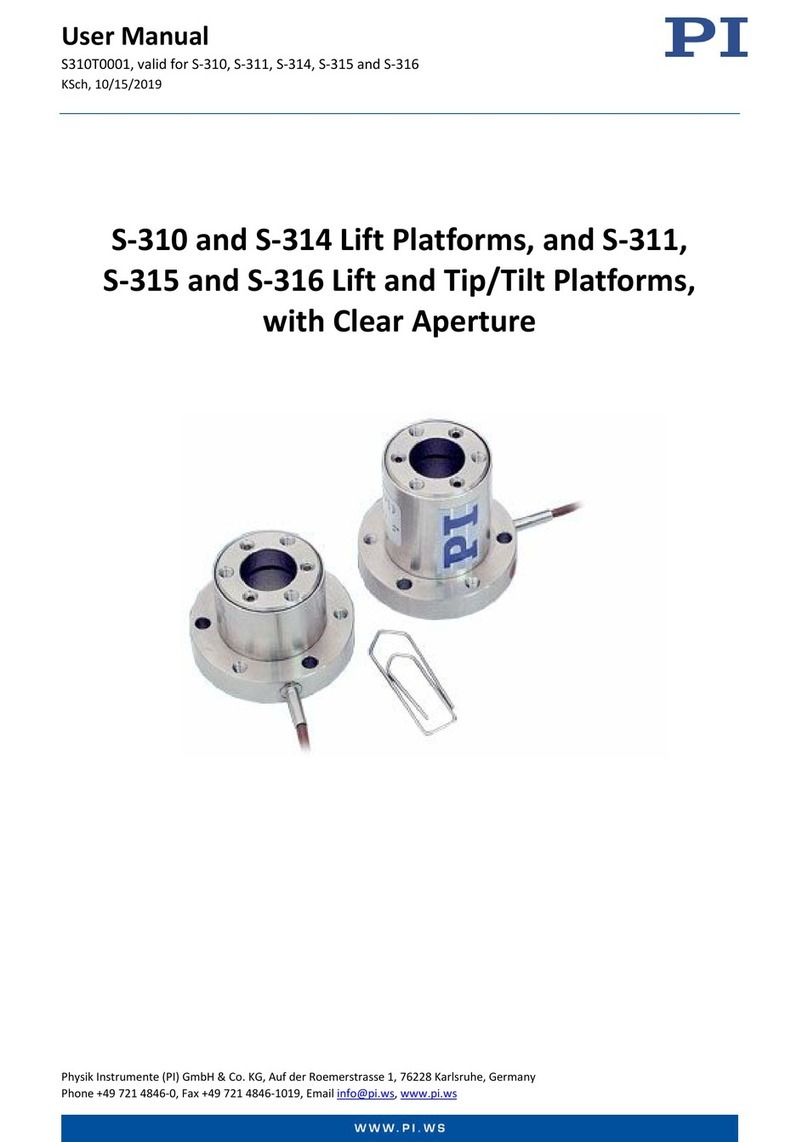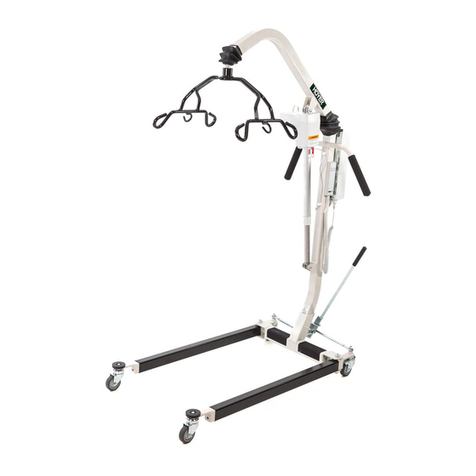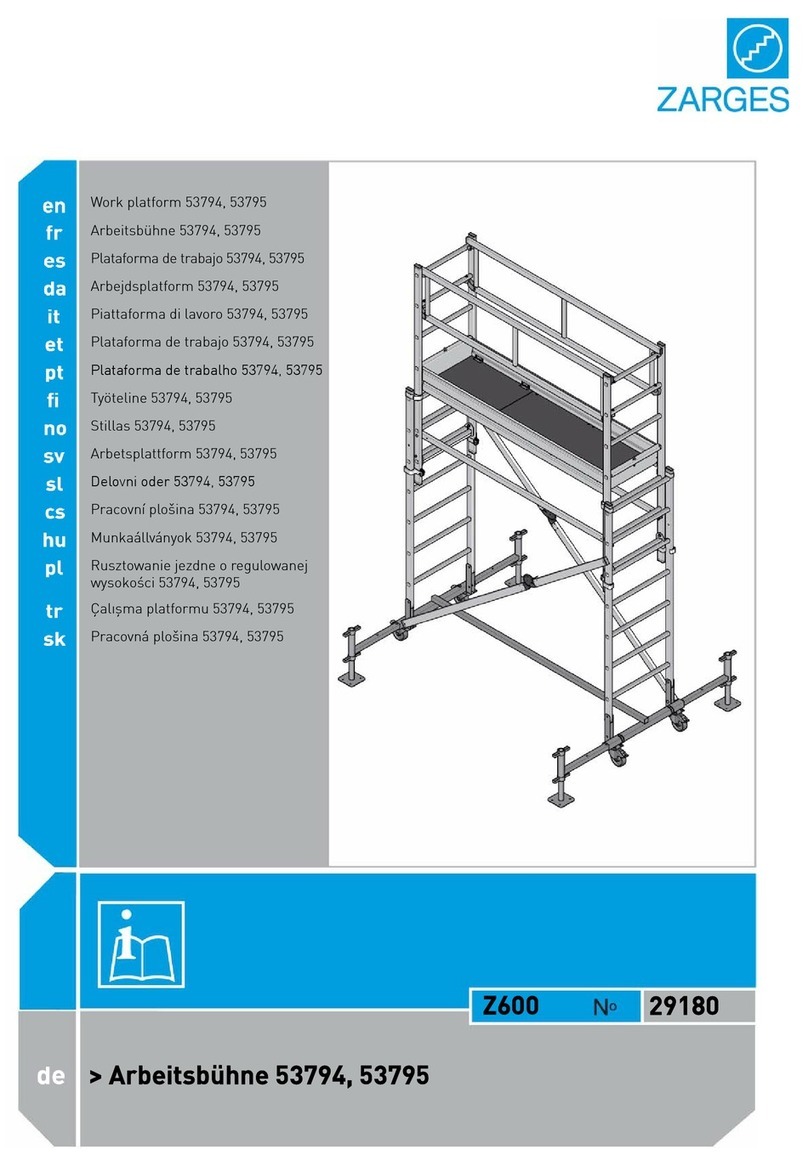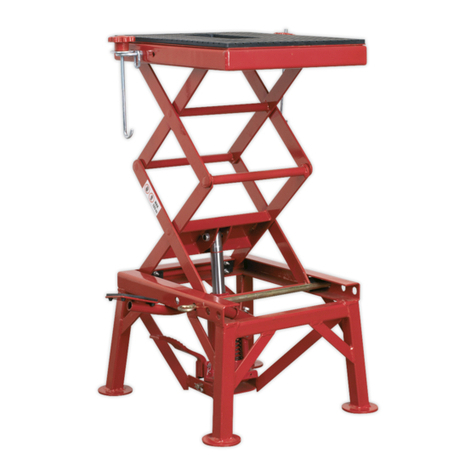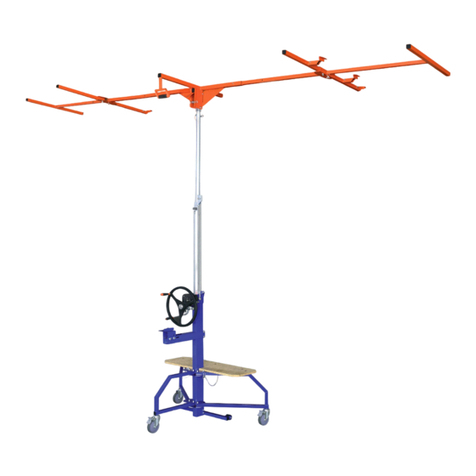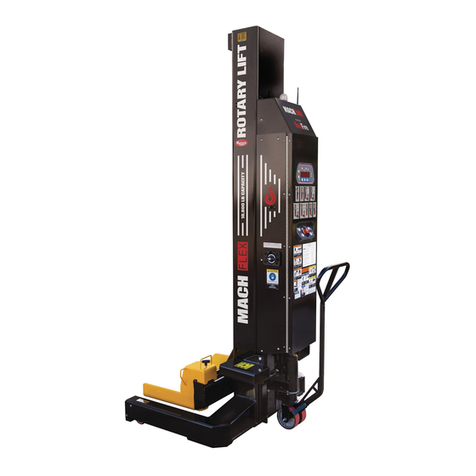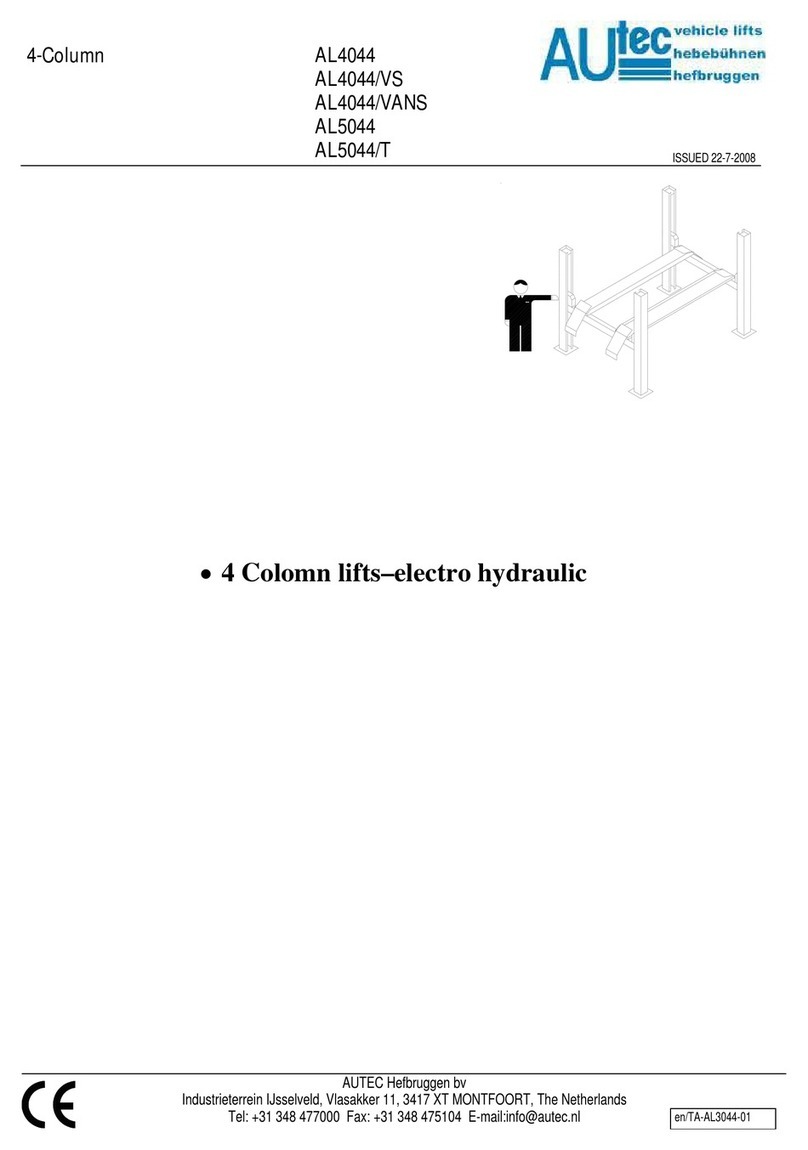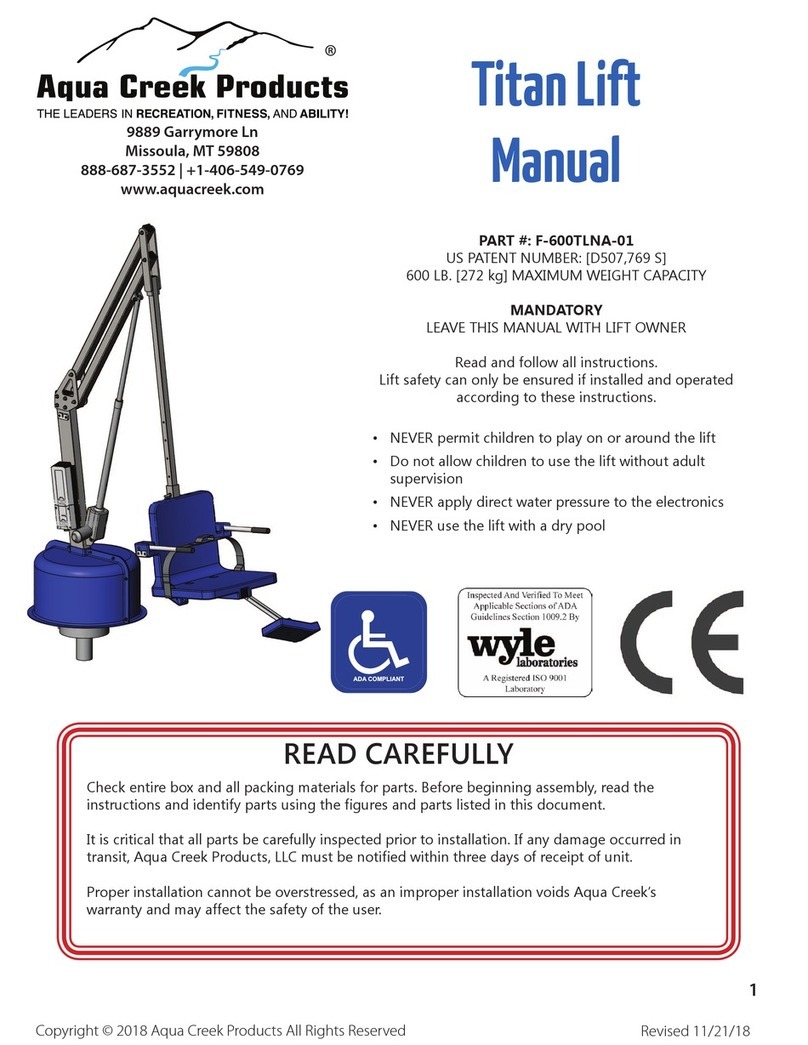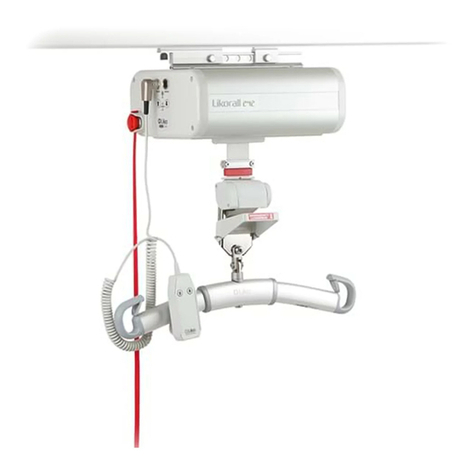Total Automotive Lifting Solutions Inc. TLS210SR*1 Guide

1
Part Number : D - TP - 10 - S
Issue 00 5 E ective : May 1 , 200 9
Supersedes Issue 00 4 - April 1 5 , 200 9
10,000 lb.( 4536 kg )
Symmetric
Two Post
READ the Manual Thoroughly Before Installing,
Operating, Servicing, or Maintaining the Lift
SAVE this MANUAL and ALL INSTRUCTIONS
Total Automotive Lifting Solutions Inc.
2300 Speers Rd. Oakville, Ontario L6L 2X8
Phone: (905) 847-1198 Fax: (905) 891-1214
www.TLSLifts.com
Model Number:
TLS210SRx1
TLS210SXx1

2
Your new lift will provide years of dependable service if installed, operated and maintained
properly. Read and be prepared to follow all safety, installation,
operation, and maintenance instructions in this manual before
installing and operating the lift. In addition, read and follow all safety
and other information included on and with the lift be fore operating
the lift. Keep this manual in a secure place for future reference,
training and service part identification.
TABLE of CONTENTS
1. Unloading Procedure and Lift Package Contents page 3
2. Warranty and Safety page 4 - 6
3. General Requirements and Lift Specifications page 7
4. Tools Required and Pre Installation Procedures page 8
5. Installation Procedures page 9 - 10
6. Operating Instructions and Lift Maintenance page 11 - 13
7. Troubleshooting page 14
8. Lift Installation Diagrams and Parts Lists page 15 - 26
IMPORTANT :It is the shop owner's responsibility to provide a satisfactory installation
area for the lift. Lifts should only be installed indoors on level concrete floors with a
minimum of 4 inches (102mm) and 3000 psi (20.7MPa) concrete that has been aged a
minimum of 30 days. Please consult a qualified individual if any doubt exists concerning
proper installation and subsequent safe operation of the lift. Do not install the lift on asphalt
or outdoors.
Prior to installation, it is the shop owner's responsibility to provide constant electrical power
in the correct voltage, phase, etc., and all wiring for electrical hook-up of the lift. The shop
owner must insure that the electrical installation conforms to local building and safety codes.
Where required, the shop owner will provide an electrical isolation switch located in close
proximity to the lift. This switch will have an emergency stop capability and isolate electrical
power from the lift for servicing requirements.
Hydraulic oil cannot be shipped with the lift and will be supplied by either the shop owner or
the installer. ISO 32 hydraulic oil (10W non detergent hydraulic oil) must be used to fill the
reservoir tank before operating the lift.
It is the shop owner's responsibility to train all operators in
lift operation and safety.

3
UNLOADING PROCEDURE and LIFT PACKAGE CONTENTS
For your information:
All lift components are grouped together in one package held at each end by steel frames.
Unpacking Procedure:
When the lift arrives on site: - If possible have lift unloaded in the installation area.
- Check for freight damage and report immediately to the
trucking company who delivered the lift.
- Check for missing parts and report immediately to the factory.
1 - 877 - 799 - LIFT (5438) or (905) 847 - 1198
Main Components include:
Power Side Column and Carriage Assembly –1 pc (c/w equalizing cable and 2 arm restraint assembles)
Opposite Side Column and Carriage Assembly –1 pc (c/w equalizing cable and 2 arm restraint assembles)
Column Extensions –2 pc
Overhead Crossmember –3 pc (c/w 4 steel cable pulleys)
Overhead Safety Shutoff Bar –1 pc
Arms –4 pc (c/w arm restraint gear assemblies)
Powerpack Assembly –1 pc
Accessory and Hardware Box includes:
Micro-switch for Overhead Safety Shutoff Bar - 1pc (c/w 2 mounting brackets and hardware)
Baseplate Shims (6mm - 3mm - 1mm assortment) - Anchor Bolt Assemblies - 10 pc
Arm Pins –4 pc (c/w roll pins to secure them)
Rubber Stack Pad Assembly –4 pc
Stack Pad Adapter (1½ " ) –4 pc
Stack Pad Adapter (3”) –4 pc
Stack Pad Adapter (6”) –4 pc
Honda Adapter –2 pc
Rubber Door Guards –2 pc
Hydraulic Hose –2 long and 1 short (also 1 hydraulic "T" fitting and powerpack adapter fitting)
Rubber Mounts for Powerpack - 4 pc
Safety Lock Release Cable –1 pc (c/w 2 pulley brackets and fittings)
Safety Lock Cover –2 pc
Fittings Box (bolts, washers, nuts, screws, cable ties, etc.)
ALI - WL101 Series Label Kit
ALI - " Lifting It Right " Manual
ALI - " Vehicle Manufacturer's Lifting Point Guide" (CD)
Automotive Lift Safety Tips Hang Card
Automotive Lift, Operation, Inspection and Maintenance Manual
Owner’s Manual

4
WARRANTY and SAFETY
Warranty: The multi-metric model two post lifts listed in this manual have the following
warranty from date of purchase:
Structural Components - 1 year Accessory Items - 90 days
Hydraulic and Other Components - 1 year Labor - 1 year
The above items are warranted to be free of defects in material and workmanship to the
original owner of the lift as follows: During the first year (90 days for accessories), those parts
proven after inspection to be defective shall be repaired or replaced at the option of the
manufacturer. This warranty does not extend to defects caused by ordinary wear, misuse,
abuse, improper maintenance, shipping damage or where repairs have been attempted or
made by anyone other than the manufacturer or a manufacturer certified technician. This
warranty is exclusive and in lieu of all other warranties express or implied. In no event shall
the manufacturer be liable for special, incidental or consequential damages for any breach or
delay in performance of the warranty. The manufacturer reserves the right to change
specifications, designs or add improvements to its product line without incurring any
obligation to make such changes to products sold previously.
IMPORTANT SAFETY INSTRUCTIONS
When using your garage equipment, basic safety precautions should always be followed,
including the following:
1. Read all instructions
2. Care must be taken as burns can result from touching hot parts
3. Do not operate equipment with a damaged cord or if equipment has been dropped or
damaged –until it has been examined by a qualified service person
4. Do not let a cord hang over the edge of the table, bench, or counter or come in
contact with hot manifolds or moving fan blades
5. Let equipment cool completely before putting away. Loop cord loosely around
equipment when storing
6. To reduce risk of fire, do not operate equipment in the vicinity of open containers of
flammable liquids (gasoline)
7. Adequate ventilation should be provided when working on operating internal
combustion engines
8. Keep hair, loose clothing, fingers, and all parts of body away from moving parts
9. To reduce the risk of electric shock, do not use on wet surfaces or expose to rain
10.Use only as directed in this manual. Use only manufacturer’s recommended
attachments
11.ALWAYS WEAR SAFETY GLASSES. Everyday eyeglasses only have impact resistant
lenses, they are not safety glasses
SAVE THESE INSTRUCTIONS
safety cont’d on page 5

5
Safety Continued
Basic common sense safety precautions should always be followed when installing, operating
and maintaining the lift as a risk of fire, electric shock, or injury may be present.
In addition:
1. Read and follow all safety instructions and decals included with the lift. Read and follow
all safety instructions in this manual. Read and follow the ALI "Lifting It Right" manual -
included with the lift. Always use the "Vehicle Lifting Points" reference guide when lifting a
vehicle –CD is included with the lift. Insure all materials stay up to date »» www.autolift.org/
2. Only trained and authorized personnel should position a vehicle and operate the lift. Do
not allow customers or bystanders to operate the lift or be in the lift area.
3. Inspect the lift daily. Do not operate if potential problems have been identified or lift
malfunctions. Do not operate if lift has damaged or broken components. Never walk or
work under the lift unless all safety locks are completely engaged.
4. Never overload the lift. The rated capacity decal is located on the powerpack column. The
hydraulic system on this lift is not designed to be a load holding devise. Mechanical safety
locks must be engaged before proceeding under the lift, with vehicle servicing, or system
maintenance. Never override operating controls. This is unsafe and will void the warranty.
5. Before driving a vehicle between the columns, position all arms to insure unobstructed
entry. Do not hit or run over arms as this could damage the lift and/or vehicle.
6. Use all 4 arms to raise a vehicle. Position all lift pads to contact vehicle manufacturer's
recommended lifting points (see "Vehicle Lifting Points" reference guide CD included with the lift). Raise lift
slowly until all pads contact the vehicle. Check all pads for complete and secure contact
with the vehicle. Check all arm restraints to insure they are engaged properly. Check
that vehicle is stable on the lift. Only after confirming these procedures, raise the lift to
desired working height.
7. Special care must be used when lifting pick-up trucks. Optional truck adapters may be
required to reach manufacturer recommended lifting points. Always use these lifting
points. Running boards and other installed accessories may also require optional adapters
Insure contents of the cargo box will not affect vehicle balance while on the lift.
8. Important: Removal or installation of heavier parts can change the vehicle's center of
gravity on the lift resulting in a critical load shift. The vehicle may then be unstable. Plan
ahead for this possibility to insure continued safety and refer to the vehicle manufacturer’s
service manual for recommended procedures.
9. Always keep the lift area free of obstructions and debris. Clean up grease and oil spills
immediately.
10. Never raise a vehicle with passengers inside. Before lowering a vehicle, check the lift and
lift area and remove all obstructions. Before removing vehicle from the lift or lift area,
position arms to the drive through position and confirm an unobstructed exit.
safety cont’d on page 6

6
Safety Instruction and Information Decal Kit (included with the lift)
LIFT SAFETY
and LIFT
MAINTENANCE
MUST BE PART
OF YOUR
DAILY
ROUTINE
IMPORTANT : Insure Safety
Instruction decals are affixed to the
lift immediately following installation
and before the lift is used
ELECTRICAL SAFETY DECAL
Review all safety
information daily
with all lift
operators

7
SYMMETRIC GENERAL REQUIREMENTS and LIFT SPECIFICATIONS
Ongoing quality improvements and design modifications may change specifications listed in this manual without notice
10,000 lb. Capacity (2,500 lbs. per lift pad)
Concrete:
minimum 4 inches (102mm) - 3000 psi (20.7MPa) - aged a minimum of 30 days.
Electrical:
230V - 1 ph - 60 Hz - 20 amp (standard) 230V - 3 ph - 60 Hz - 15 amp (optional)
Extended
Height
Model

8
TOOLS REQUIRED and PRE INSTALLATION PROCEDURES
Tools Required: Gather all the tools listed below.
4” x 4” Wooden Blocks (for unpacking)
16ft. Measuring Tape
Chalk Line and Chalk
Side Cutters
Crow Bar
Metric Wrenches and Ratchet Set
SAE Wrenches and Ratchet Set
Metric and SAE Allen Key Sets
Hammer
Screwdrivers
12 ft. Step Ladders - 2
(2 people using 12 ft. ladders should install the overhead crossmember assembly)
4 ft. Levels - 2
Rotary Hammer Drill with 3/4” diameter Masonry Drill Bit
Pre Installation Procedures
Before proceeding with installation, read the installation manual and insure all instructions
are fully understood and all component parts are accounted for.
1. In the installation area, identify the center line of the bay and mark the floor. Also mark
the center of bay entrance door. Connect these two points with a short chalk line in the
area where lift will be located. Draw a second chalk line at 90° to locate the positions of
both lift columns (refer to lift dimensions and bay layout on page 6). Insure each lift column is
equal distance from bay centerline and each baseplate maintains a minimum distance of
6 inches from any floor seam. Do not install if floor has cracks or deterioration that could
affect lift stability. The shop owner is responsible for confirming there are no obstructions
in the installation area like floor drains, under floor piping or electrical conduit that could
be damaged or prevent safe lift installation and secure lift anchoring. Check ceiling for
beams or heating ducts and walls for protruding structures, etc.. Model TLS210SRR 1/3
has two possible overall heights - 148½ inches or 138½ inches. Model TLS210SXR 1/3
has an overall height of 172”. Confirm that the overall height you intend to install will fit
in the bay. Insure that the lift can be safely installed in the position you have marked out on
the bay floor.
2. Place the lift on wooden blocks so that the steel shipping frames can be removed.
3. Remove protective wrapping. Clear installation area of all packaging materials.
4. Unbolt steel shipping frames and remove from installation area.
5. Carefully remove top column and lay on the floor (carriage side up).
6. Carefully remove column extensions (2 pc), cross-member (3 pc), overhead safety bar,
arms (4 pc), powerpack and hardware box from the lower column.
7. Identify powerpack column (reference diagram #1). Move (carriage side up) to
appropriate location placing the baseplate end on your floor marks. Similarly, move the
second column to the opposite location.

9
INSTALLATION PROCEDURE
See the Installation and Parts Reference section of this manual for diagrams and parts lists that
will assist you during the installation process (pages 15 –26). Use these diagrams and parts
lists together with the following written instructions. Insure the lift installation complies with
ANSI/ALI/ALIS, Safety Requirements for Installation and Service of Automotive Lifts.
1. With columns laying on the ground (carriage side up), tightly fasten one column extension to
one column using bolts, washers and nuts provided (reference diagram #1). Use the
appropriate bolt hole locations to achieve either a 148½ inch or 138½ inch overall height.
Repeat this procedure with second column. Note: Model TLS210SXR1/3 has a 172” overall height.
2. Layout all pieces of the overhead crossmember on the floor and fasten tightly together
using bolts, washers and nuts provided (reference diagram #2).
3. Identify all parts for overhead safety shut-off bar (reference diagram #2). Tightly fasten
these parts to overhead crossmember with bolts, washers and nuts provided.
4. Raise (stand up) each column so that its baseplate is located on the floor marking you made
earlier. Confirm that baseplate angles and measurements between columns match lift
specifications on page 5. Use extreme caution to insure the columns do not fall
over. Secure baseplate of the most level column by installing one only anchor bolt.
5. For optimum safety, two installers should lift and secure the overhead crossmember to
both columns using bolts, washers and nuts provided (reference diagram #2). Hand
tighten all crossmember nuts and bolts. Final tightening is completed in step 9.
6. Using two 4 ft. levels and required shims, level each column vertically on all four sides
(reference diagram #3). Use extreme caution to insure the columns do not fall
over. IMPORTANT: When leveling each column using anchor bolts provided, do not
use more than ¾ inch (19 mm) of shims under any area of the baseplate. Use a 4 ft. level
to confirm the overhead crossmember is also level and at 90 degrees to both columns.
7. Drill and install all anchor bolts, washers and nuts (reference diagram #3). Insure that each
nut is torqued to 150 ft-lbs (204Nm).
This should be checked monthly.
8. One equalizing cable comes partially installed on each carriage. Before feeding a cable up
its column to the overhead crossmember, insure the cable is properly seated around the
lower pulley at the base of each column (reference diagram #4). Route each cable up its
column, over the appropriate pulleys in the overhead crossmember, and lower it down to
the opposite carriage. Insure both equalizing cables are properly seated in overhead
crossmember pulleys. Thread one nut to its farthest point on each equalizing cable.
Insert threaded end into appropriate location on the carriage. Install and hand tighten
second nut to secure each cable. Final equalizing cable adjustment is step 17. Install
two bolts and nuts to prevent unintentional cable displacement (reference diagram #4).
9. Completely tighten both sides of the overhead crossmember to its column.
10. Identify component parts for the safety release cable (reference diagram #5). Install
safety release cable so that safety locks in both columns will completely disengage when
lift is lowered. Final safety release cable adjustment is step 16.
11. Identify parts to install arms (reference diagram #6). Install all 4 arms and arm pins.
Secure each arm pin by inserting roll pin provided. Arm restraint adjustment is step
12. Install rubber mounts on powerpack bracket (reference diagram #7). Keeping these
rubber mounts between the powerpack and the mounting bracket, securely fasten
powerpack to the mounting bracket.
installation procedure continued on page 10 ………..

10
13. Identify parts for hydraulic system installation (reference diagram #7). Tightly fasten
hydraulic lines to "T" fitting. Locate "T" assembly in overhead crossmember and route
the appropriate lines to cylinders and powerpack. Tightly fasten all hydraulic lines and
secure these lines to both columns and overhead crossmember using hardware provided
(7 positions - reference diagram #7).Insure that nothing will rub or wear the hydraulic lines.
14. Attach microswitch to overhead safety bar bracket on powerpack side of overhead
crossmember Install carriage upper limit microswitch on power side column extension
(use lower 4 holes for 138½ ” height and upper 4 holes for 148½” and 172” height – see
diagram #8). NOTE: the following three procedures should be performed by a
certified electrician. Wire overhead safety bar micro-switch and upper limit microswitch
to the powerpack. Wire powerpack to shop electrical system.
15. Fill powerpack reservoir with ISO 32 hydraulic oil.
16. Operate the lift with no vehicle and no other weight. Raise lifting carriages
approximately 30 inches. Confirm that safety locks on both sides engage properly while
lift is being raised. Verify that both lifting cylinders are properly seated in the baseplate
locator hole. Continue raising lift to full height confirming safety locks are engaging.
Adjust safety release cable to insure safety locks can be completely disengaged while
lowering lift (reference diagram #5). Insure that no people or obstacles are near the lift
when adjusting the safety release cable. Lower lift completely. Raise and lower the lift at
least three times or until all air in the hydraulic system is removed.
17. After confirming that all air has been bled from the hydraulic system,
adjust equalizing cable tension as follows: (also reference diagram #4)
(Step 1) Hold top of threaded stud with a wrench to prevent
it from rotating.
(Step 2) Tighten nut "B" until all loose slack is removed
from the cable. Do not over tighten.
(Step 3)Firmly tighten nut "A" to lock cable in place. Repeat
this process for the other cable insuring both cables
have the same degree of tightness.
18. Raise lifting carriages approximately 12 inches off the floor.
Choose one arm and align arm restraint gear with locking
plunger insuring both components mesh smoothly and
totally (reference diagram #6). Completely tighten all arm
restraint gear locking bolts to maintain this position. Lower
carriage to the floor to insure arm restraint disengages in
the down position. Raise the lift 12 inches off the floor to
insure arm restraint engages smoothly and totally. Repeat
this process with the remaining 3 arms. Raise and lower
the lift once more to confirm all arm restraints totally engage
and disengage smoothly.
19. Install safety lock cover on each column (reference diagram #9).
20. To avoid damage, safety instruction and information decals are not applied at the factory
but shipped with the lift. The ALI - WL101 Series Label Kit must be applied to lift columns
before the lift is used (reference diagram #10). Insure that all lift operators are
trained in all points covered by this label kit.
Insure this manual along with all operation, inspection and maintenance
instructions are delivered to the owner/user/employer

11
Final Checkout Procedure of Assembled Lift
Check hydraulic oil level in reservoir. Confirm hydraulic connections are tight with no leaks
Confirm that both columns are level and properly shimmed with all anchor bolts torqued
to 150 ft.-lbs. (204Nm). Confirm lift stability
Confirm that all electrical components have been wired properly and are operational
Confirm that all cables are adjusted properly
Confirm safety locks and arm restraints are functioning properly
Lubricate all lubrication points
OPERATING INSTRUCTIONS and LIFT MAINTENANCE
LIFT OPERATION: Before lifting a vehicle, insure all operators are qualified, have
been trained and are following all safety instructions. Read and follow the ALI
"Lifting It Right" manual included with the lift. Always use the "Vehicle Lifting Points"
reference guide when lifting a vehicle (CD included with the lift). Insure all materials
stay up to date » » www.autolift.org/ (see example of SAE J2184 standard below)
Insure the vehicle is securely positioned on the lift
using manufacturer's recommended lifting points.
Insure all arm restraints are totally engaged.
Never allow anyone under the lift when raising or
lowering it with or without a vehicle. Always
confirm safety locks on both sides of the lift are
completely engaged before proceeding under a
vehicle.
Lift electrical operating controls are located on the
powerpack (one "up" button for raising the lift and one
"down" lever for lowering the lift). Before lowering,
slightly raise the lifting carriages to release pressure
from both safety locks. Two hands must be used when lowering the lift. One hand must
operate the safety lock release lever (located on the column above the powerpack) and one hand
must operate the "down" lever. Make certain the safety locks do not accidentally re-engage
while lift is being lowered. Customers and bystanders should not be in the lift area.
LIFT MAINTENANCE : Before maintaining, servicing or repairing the lift, insure that an
acceptable "lock out/tag out device is activated.
The following minimum maintenance schedule must be performed by the owner and/or lift
operator:
DAILY: - Raise and lower the lift (with no vehicle) at the beginning of each shift to verify it is
operating properly and carriages are level. Confirm all arm restraints engage and
disengage smoothly and totally and telescoping arms have no excessive movement.
- Check all hydraulic fittings and lines for damage or leaks. Check electrical wiring for
damage. Check all moving parts for uneven or excessive wear. Repair or replace all
damaged, worn, or broken components immediately.
- Remove oil/grease on all lift pads.… lift maintenance continued on page 12 ...

12
WEEKLY: - Check hydraulic fluid in powerpack reservoir. (confirm no leaks before topping up )
- Check equalizing cable adjustment. Check safety lock release cable adjustment.
MONTHLY: - Check that all anchor bolts are torqued to 150 ft-lbs (204Nm).
- Clean and lubricate arm restraints. (confirm all components are in good condition)
- Lubricate safety locks in both columns.
- Check that overhead safety shutoff is operating properly.
EVERY TWO MONTHS: - Remove and grease arm pins –reinstall insuring secure fit.
- Clean and re-grease slide block channel in both columns.
- Clean and lubricate all cable pulleys.
EVERY YEAR: - Arrange for a Trained Lift Service Person to inspect and certify all aspects of
the lift as per "Automotive Lift Operation, Inspection and Maintenance"
(ALOIM) guidelines. Confirm that both equalizing cables meet the standard
outlined on page 13
EVERY TWO YEARS: - Change and replace hydraulic oil in cylinders and powerpack.
Lubrication Specifications: -where grease is required use a multi-purpose lithium grease
- where lubricating oil is required use WD-40 or a SAE 30 oil
- where hydraulic oil is required use ISO 32 –10W non detergent
hydraulic oil.
lift maintenance continued on page 13 ………..

13
The following criteria will determine when an equalizing cable is no longer
acceptable for service:
12 randomly distributed broken wires in one lay or four broken wires in one strand in one lay
in running ropes
one outer wire broken at the contact point with the core of the rope, which has worked its
way out of the rope structure and protrudes or loops out from the rope structure
wear of one-third the original diameter of outside individual wires
kinking, crushing, birdcaging, or any other damage resulting in distortion of the rope structure
evidence of heat damage from any cause
reduction from nominal diameter greater than those listed in the following table:
Note: Attention shall be given to end
connections. Upon development of two
broken wires adjacent to socket end
connections, the rope shall be resocketed
or replaced. Resocketing shall not be
attempted if the resulting rope length will
be insufficient for proper operation.
Rope Diameter
(inch)
Maximum allowable
reduction from Nominal
Diameter (inch)
Less than or
equal to 5/16
1/64
More than 5/16
to 1/2
1/32
More than 1/2 to
3/4
3/64

14
LIFT PROBLEM TROUBLESHOOTING GUIDE
The following are some suggestions to consider if problems are encountered with the lift. Please
call a Trained Lift Service Person for further clarification and information.
1. Lift does not operate:
Possibilities include - blown fuse or tripped circuit breaker –tripped thermal overload on
motor –defective "up" button. Call a qualified electrician for all wiring questions.
2. Motor runs but lift does not rise:
Possibilities include –low hydraulic oil level (check reservoir tank) - dirt under check
valve (press "down" lever and "up" button at the same time for 10-15 seconds. This will
clear small contaminants. If this fails clean check valve ball and seat by removing valve
cover). Call a Trained Lift Service Person if problem continues.
3. Motor noise (drone or hum) but will not run:
Possibilities include –low voltage, faulty wiring or faulty capacitor (call electrician to
confirm) –lift is overloaded ( insure vehicle weighs less than rated lift capacity).
4. Lift falters or jerks when it is raised or lowered:
Possibilities include –air in the hydraulic system (cycle lift all the way to the top and
completely lower 3 –4 times. If this does not solve the problem call a Trained Lift Service
Person.
5. Excessive noise when raising or lowering lift:
Possibilities include –pulley assemblies need lubricating –cable is off the pulleys –
carriage sliders need grease –carriage sliders are broken. Do not operate the lift with
broken or damaged carriage sliders or dislodged cable. Replace immediately.
6. Lifting carriages are unequal when raised:
Possibilities include –improperly adjusted equalization cables –air in the hydraulic
system. Adjust cables or call a Trained Lift Service Person to correct the problem.
Replace all worn or broken parts and components only with
manufacturer approved/supplied parts and components
Replacement parts may be purchased from your local lift supplier or the
manufacturer at 1 - 877 - 799 - LIFT (5438) or (905) 847 - 1198

15
for installation & service part reference
SAVE this MANUAL and ALL INSTRUCTIONS
Part Numb er : D - TP - 10 - MM
Issue 00 5 E ective : May 1 , 200 9
Supersedes Issue 00 4 - April 1 5 , 200 9
10,000 lb.
( 4536 kg )
Multi-Metric
Two Post
Total Automotive Lifting Solutions Inc.
2300 Speers Rd. Oakville, Ontario L6L 2X8
Phone: (905) 847-1198 Fax: (905) 891-1214
www.TLSLifts.com
Model Number:
TLS210SRx1
TLS210SXx1

16
LIFT ILLUSTRATIONS and PARTS LISTS
The diagram below identifies main component parts and the order in which they are to be
installed. Numbers correspond to installation diagrams found in the chart below and on
following pages. Page numbers for each diagram is also found in the chart below. These
diagrams, along with related parts lists, will assist you when installing and servicing this lift.
Please insure these lift diagrams and parts lists are kept in a secure place for quick reference.
Diagram
Number
Diagram Description c/w Parts Lists
Page
Number
1
Lift Columns and Column Extension Assembly
17
2
Overhead Crossmember - Safety Shutoff Bar with Microswitch
18
3
Lift Leveling - Column Shimming - Anchor Bolt Installation
19
4
Equalizing Cable Installation
20
5
Safety Release Cable Installation
21
6
Lift Arm and Arm Restraint Installation
22
7
Hydraulic System
23
8
Powerpack and Overhead Safety Bar Microswitch Wiring
24
9
Safety Dog Cover Installation
25
10
Safety Decal Installation
26

17
Diagram #1 : LIFT COLUMNS AND COLUMN EXTENSIONS
PARTS LIST

18
Diagram #2 : OVERHEAD CROSSMEMBER ASSEMBLY
(includes safety shutoff bar and equalizing cable pulleys)
Item
Part Number
Description
Qty
1
12100016
Standard Tower Extension
2
2
12100094
Overhead Crossmember Channel
2
3
12100588-1
Symmetric Channel Bracket
2
4
12100095
Overhead Channel Brace
1
5
32103035
Equalizing Cable Retainer Bolt M6 x 35
8
6
32103036
Nut M6
8
7
12100102
Overhead Shut-off Mounting Bracket-Left
1
8
12100111
Overhead Shut-Off Bar
1
9
12100103
Overhead Shut-Off Foam Guard
1
10
42100010
Overhead Shut-off Microswitch (Mount on Powerpack Side)
1
11
32103035
Hex Head Bolt M6 ???
1
12
32103036
Hex Nut M6 ???
1
13
12100098
Overhead Pulley
4
14
12100096
Pulley Spacer
2
15
32100034
External Retaining Ring 20MM
4
17
32100532
Hex Nut M10X1.5
16
18
32100506
Plain Washer 10MM
16
19
32100507
Spring Lock Washer 10MM
16
20
32100530
HHMS M10X1.5X25
8
21
32100531
HHMS M10X1.5X30
8
22
32100020
M8 x 1.25 x 16 Hex HSCS
1
23
32100044
10 mm Flat Washer
1
24
32100027
Hex Nut M8 x 1.25
1
25
32100025
Hex Cap Screw M6 x 1.0 x 25
2
26
32100026
Spring Washer
2
27
32103026
Hex Nut M6 x 1.0
2
PARTS LIST

19
Diagram #3 : LIFT LEVELLING - COLUMN SHIMING - ANCHOR BOLTS
PARTS LIST
Item
Part Number
Description
Qty
1
3000539
3/4"x5" Concrete Anchor
10
2
3000540
Shim-6mm
10
3
3000541
Shim-3mm
10
4
3000542
Shim-1mm
10

20
Diagram #4 : EQUALIZING CABLES
PARTS LIST
Item
Part
Number
Description
Qty
1
32100000
Equalizing Cable
2
2
12100098
Overhead Pulley
4
3
12100043
Equalizing Pulley
2
4
42100011
Carriage Assembly
2
5
32100591
Cable Stud 12 x 1.5
4
6
32100038
Heavy Hex Nut M12
8
7
32103035
1/4” x 13/8” or M6 x 35 mm Bolts
4
8
32103036
1/4“ or M6 Nuts
4
This manual suits for next models
1
Table of contents
Other Total Automotive Lifting Solutions Inc. Lifting System manuals
Popular Lifting System manuals by other brands

MoJack
MoJack MoJackPRO Instructions for assembly and operation

Rotary Lift
Rotary Lift 200 Series installation instructions
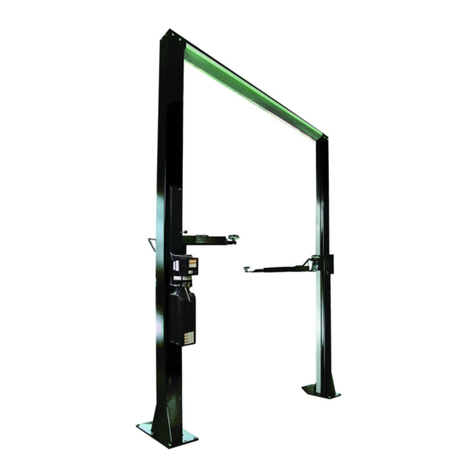
Nussbaum
Nussbaum SPL 8 Series owner's manual
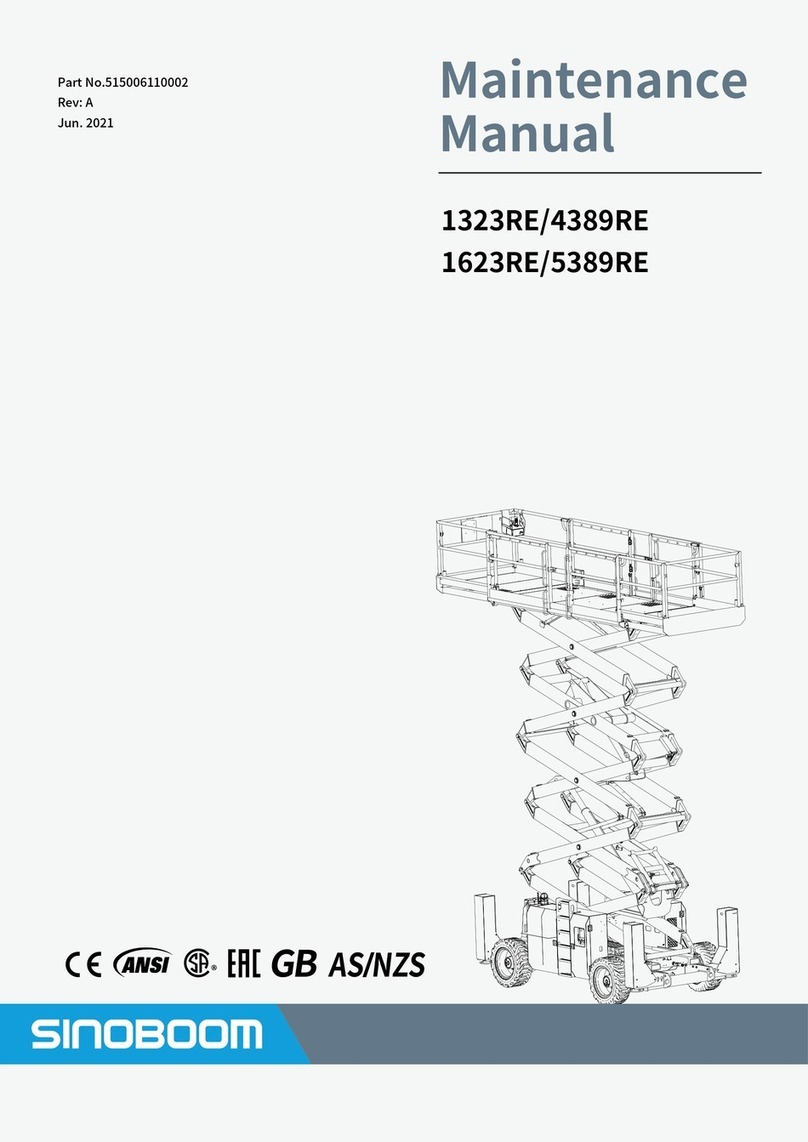
Sinoboom
Sinoboom 1323RE Maintenance manual
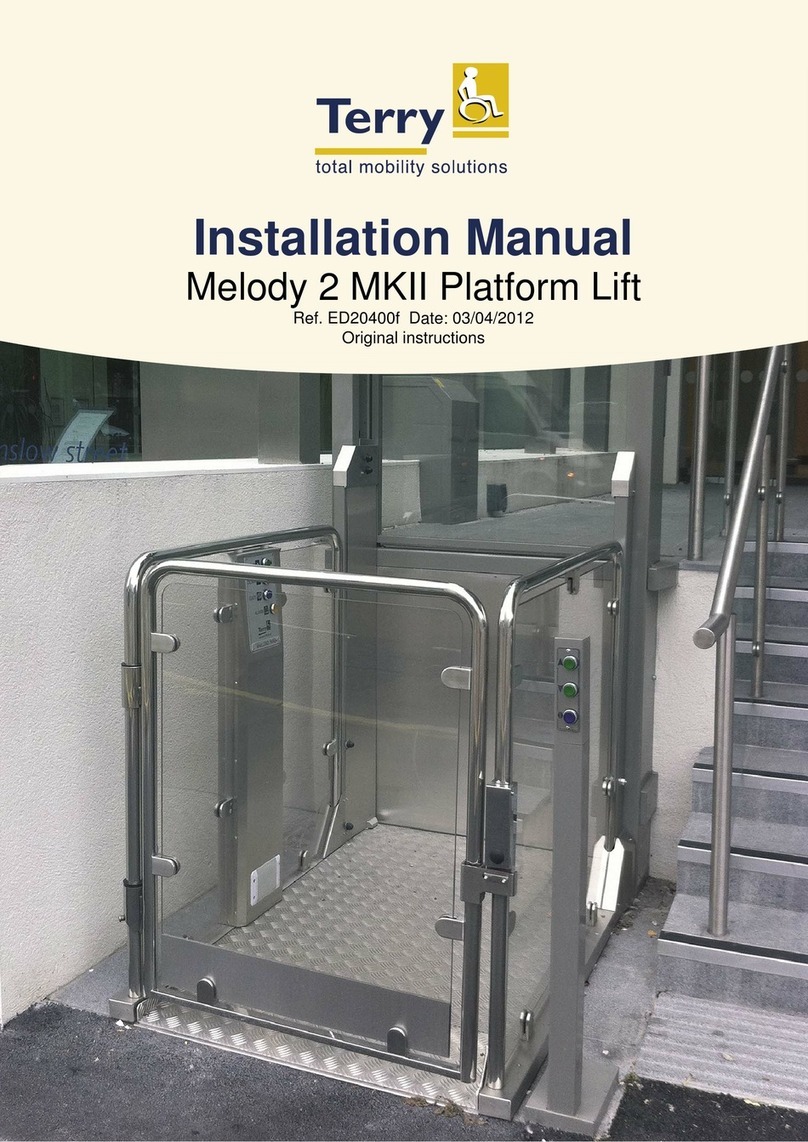
TERRY
TERRY Melody 2 hydraulic MK2 installation manual
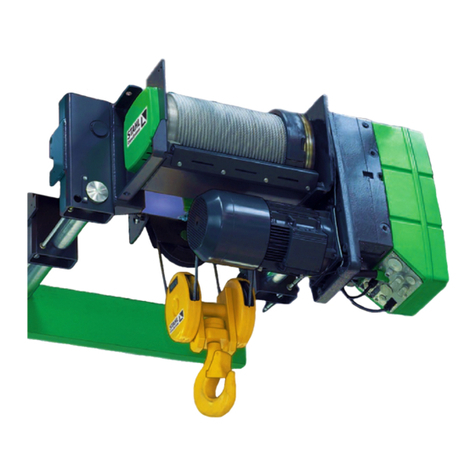
Stahl
Stahl SH 3 Operating and maintenance instructions

